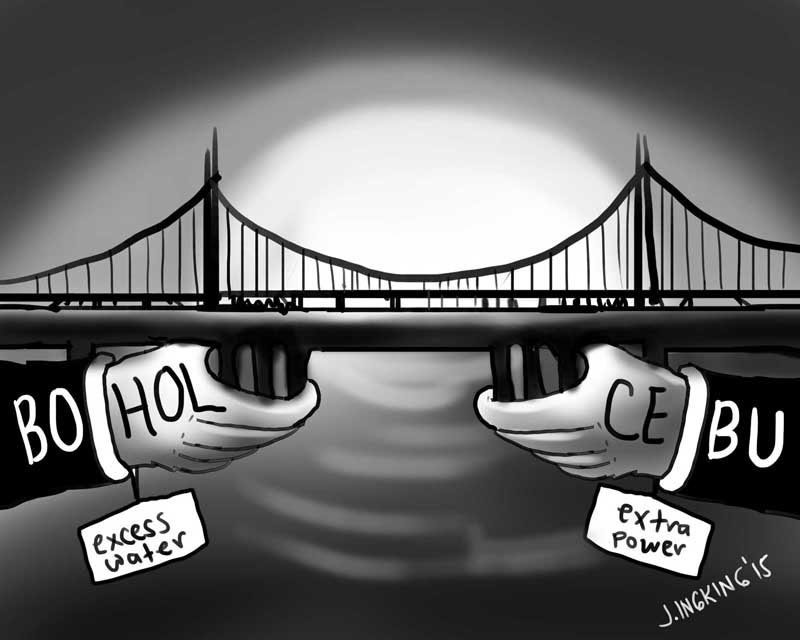
The phrase best describes why the proposed Bohol -Cebu Multi Access Bridge appears viable wherein  Bohol needs Cebu’s excess power and Cebu needing Bohol’s extra water from the expansive Inabanga River.
Eight of ten Boholanos surveyed favor it  (per sister station dyRD’s survey)and- crossing party lines- Rep Aris Aumentado of the second district and Governor Edgar Chatto are both endorsing the project vigorously though the NEDA /ICC and Congress as a priority project.
It is also a fulfillment of one of the dreams of the late Rep/Gov, Rico Aumentado as the 17.5 kilometer bridge falls on Getafe , a part of the second district, linking to Cordoba Cebu – the shortest distance between two points (Bohol and Cebu).
The project cost does not come cheap – some US $2.5-B of about close to P 100-B (is projected) which certainly dwarfs the “measly” P7.2- Billion contemplated Bohol New Panglao International Airport.
There are reportedly two Australian firms bullish not just in funding the feasibility study but  to go through the project as a major partner of government under the BOT (Build Operate and Transfer) scheme.The bridge will be the physical conduit to “transfer ” both power and water to and from both provinces -unlike the more expensive and dangerous  underwater cables linking Bohol to Leyte’s geothermal electricity source.
Certainly trade and commerce will blossom even more between the two neighboring Visayan islands and probably gives a slight advantage to Boholano entrepreneurs ,especially those agriculture in nature, as Cebu has a markedly bigger market absorptive capacity for new goods and services.
There will no longer be that horrible Signal No 1 Syndrome that had bedeviled passengers of both islands who are automatically stranded at where they are located at the say so of Pagasa. Tourism will be a great beneficiary with Bohol’s more rustic laid back tour sites complemented by Cebu’s more sophisticated  packages including a vibrant night life- almost as bombastic as Manila’s. The tour synergism between the two will be enhanced.
The site of Getafe could provide a more quiet ambiance for residential living for Cebu and Mactan residents who  may want to avoid the noisier, more trafficked burden environs in Cebu  and heavier property taxes there.
Like the Chinese dictum, however, there is always a yin for every yang-and vice versa- and there could be drawbacks.
The “connection” could lead to Bohol somehow losing its own sense of identity and be dominated by the more imposing logistical and personality traits of Cebu and its people, in general.A backyard of Cebu- Bohol would not want to be labeled.Not now,not ever.
It is a known fact that citified places like Cebu are likely to harbor more criminal elements and sophisticated modes of “one up-manship” that can seep into the crevices of Bohol’s more laid-back and peaceful foundations. With bigger capital, organization and technology, Cebu businesses might enter Bohol in inordinate volume and finances as to drown the existing smaller entities here.
Very clearly, the pros, however, outrank the cons in a major way. But there are many things still to be clarified under the context of a BOT structure for the project.
(1) Â With over P100-Billion in investments, is there enough traffic (physical) to justify the vehicle “fees” to justify the investors pay-back period (in number of years) and their internal rate of returns (IRR)?
(2) Definitely, Government cannot participate in a major way in the funding  (only as small counterpart, perhaps) since a P100-Billion investment (if funded by public financial resources) will  obviously deprive other provinces of infrastructure funded by the  the GAA (National Budget).
(3) The Investor will then try to recoup its investment on their own decided targeted rates of business capital  returns and may result in higher toll fees for the “use of passage” for both water and power -and making the resulting utility rates for both provinces “expansive and uncompetitive”.
(4) A real NEDA (not investor-driven) study must be  similarly made to extrapolate the real needs of Boholanos for water over  the  very long term (20-50years)  and extract a scenario whether yielding part of the Inabanga river resources will not eventually compromise supply availability.
(5) The “dependence ” on Cebu power might  weaken  again the  politically-correct Bohol resolve to develop its own renewable and Bohol-based sources of electricity and  might just transfer the power source dependence from Leyte to Cebu.
All of these economic aspects must be studied with the full backing of scholarly scientific research- because making it logical and economically palatable to the people will make  the most needed “social acceptance’ modality be achieved quicker and easier.
Let us also hold our horses  also a bit over this exciting project -since  this undertaking takes two to tango.
Which means that not only Boholanos but the Cebuanos themselves as well  must agree to this joint undertaking. Interviewed last by Freeman Cebu, the Cordoba Mayor said recently this is the first time he had heard the Cebu-Bohol Friendship Bridge idea as  revived since after the death of its “Father”- the late Rico Aumentado.
The CHRONICLE , less we be misconstrued, is four square supportive of the concept of the de facto “barter” of water and power and a bridge to connect businesses and tourism of the two friendly neighboring provinces.
But let us just make sure that the project will not just benefit the present generation but prevent the deprivation of the succeeding generation for an element as basic to life as water.
Let’s get the numbers clear and we offer our twin media facilities to propagate the benefits as long as the conclusions are valid and fool-proof.
Let’s go – Bohol and Cebu. Hands together for progress for our people.
For comments: email to dejarescobingo@yahoo.com or bohol-rd@mozcom.com
